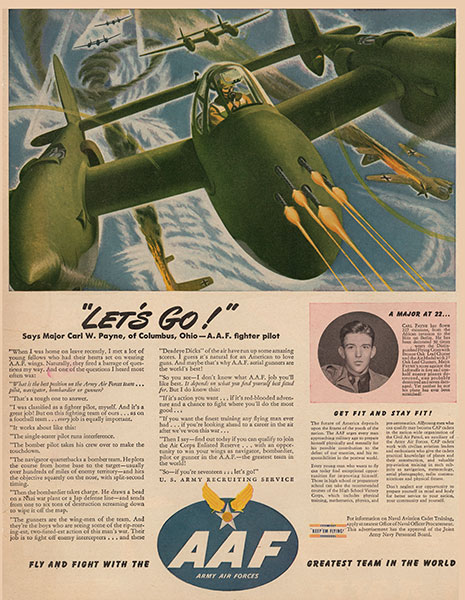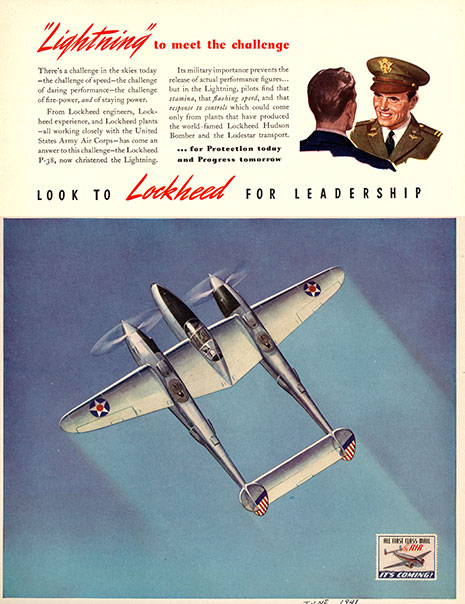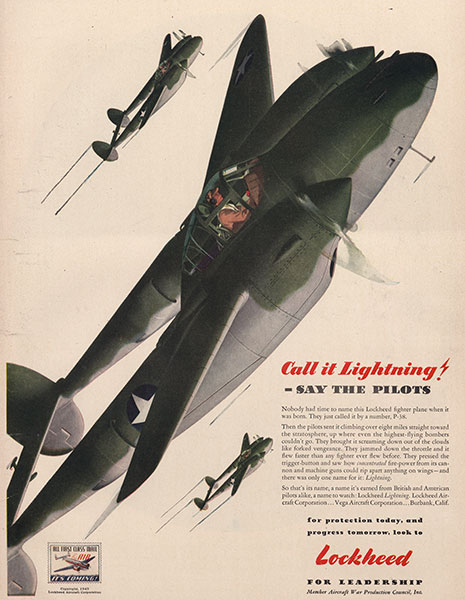

Easily the most recognizable aircraft silhouette in the United States arsenal during WWII, the unorthodox design of the P-38 owed its development to the foresight of a small group of Army Air Corps officers who, concluded that unacceptable limitations were being placed on fighter design by “peacetime” thinking. With fuel loads dictated by the size of the American mainland and overall weights limited by available engine powers, the amount of armament would be effectively limited to about 500 lbs, which approximated to one .30 cal and one .50 cal machine guns plus a few hundred rounds. To carry double this armament, a twin engine fighter seemed to be essential. To overcome prejudice towards development of a twin engine design, the Army Air Corps officers called it an interceptor rather than a pursuit.

In 1936, a general specification for two high altitude interceptors was issued. It called for an aircraft with a high rate of climb, a speed of 360 mph at 20,000 feet and an endurance of one hour at full throttle. Both were expected to carry a heavy armament (by mid ‘thirties standards), to have engine turbo superchargers and tricycle undercarriages.
Although Lockheed had never built a fighter, they made the decision to enter the competition. The responsibility for the new design was handed off to the two man team of Hal Hibbard as chief engineer and Kelly Johnson. The P-38 was designated Lockheed Model 22. For the time, it was a complex design and not an easy aircraft to produce. The development was a long process with a number of problems to solve. In fact, the Lightning was not considered combat ready until the August of 1940 with the appearance of the P-38E. While it was placed into service with ever increasing numbers, the true performance of the Lightning would not be realized until November 1944 when the late P-38J’s were delivered with hydraulic combat maneuvering flaps to control the problem of compressibility.

The XP-38 made its first test flight January 27, 1939. At that time it proved a quantum leap forward. The twin Allison V-1710-11/15 each developed 960hp at 12,000 ft. To combat torque, the props rotated inward. The supercharger intercooler formed part of the outboard portion of the wing leading edge. The entire aircraft was done with smooth skinned panels. At the time of its first flight, it was the fastest non-racing plane in the world.

The P-38D was considered the first production P-38 that met the USAAF combat requirements. It was armed with four .050 machine guns and a single 37mm cannon. It was fitted with self-sealing fuel tanks, a retractable landing light, and provision for flares. The old high pressure oxygen system was replaced with a low pressure system that would remain standard on all subsequent models as well as outwardly rotating props. Only 26 P-38D’s were delivered to the USAAF in June of 1941. It was the first P-38 to be christened with the name “Lightning”.

While the outward appearance was the same, the P-38E contained thousands of internal changes. The 37mm cannon was replaced with a 20mm cannon. The nose section was redesigned to double the ammunition capacity. The electrical and hydraulic systems saw numerous revisions. The Hamilton Standard props were replaced with Curtis Electrics with Dural blades. A total of 238 P-38E’s were produced. A P-38E made its first kill of WWII within minutes of the US declaration of war by downing a Focke-Wulf Condor over the Atlantic.

The P-38F was the first truly operational Lightning which arrived in late 1942. It featured Allison V-1710-49/52 engines producing 1,325 hp. There were 527 P-38F’s produced. It was the first P-38 to be fitted with underwing racks for bombs or fuel tanks. These were the first Lightning’s to take part in large scale operations in North Africa. The P-38G was similar to the “F” but boost was increased to 1,150 hp at 27,000 ft. The “G” model also saw revisions of the supercharger equipment. The “G” was the most widely produced of the early lightnings with 1,082 built.

The P-38H was a stop-gap version that saw a change to the Allison V-1710-89-91 with an increase to 1425 hp. The increased horsepower meant an increased need for adequate cooling. Automatically operated oil radiator flaps were introduced in an effort to control persistent cooling problems that would never be solved until the introduction of the P-38J. The supercharger air intakes were enlarged. An M-2C cannon replaced the M-1 and bomb capacity was increased to 1600 lbs. per rack. The P-38H went into service in May of 1943.

The P-38J saw the first visual change in the P-38 profile. The “J” had the same engines as the “H” but the intercooler air intake was now sandwiched between the oil radiator intakes resulting in the characteristic beard radiator. The leading edge space formally occupied by the intercooler was converted to a 55 gallon fuel tank increasing the ferry range to 2,260 miles and an endurance of 12 hours. The beard radiator added a bit of drag, but at 420 mph, the P-38J was the fastest Lightning of the series. The engine coolant radiators were also enlarged. The curved windscreen was replaced with a flat panel with the P-38J-10-LO. Electrically operated compressibility flaps were introduced at P-38J-25-LO along with hydraulically boosted ailerons.











Bodie, Warren M. The Lockheed P-38 Lightning. Hiawassee: Widewing Publications, 1991
Hagan, Klaus and Kinzey, Bert. Lockheed P-38 Lightning, Part 1. Las Vegas: Detail & Scale, 2024
Hagan, Klaus and Kinzey, Bert. Lockheed P-38 Lightning, Part 2. Las Vegas: Detail & Scale, 2024
Scutts, Jerry. Lockheed P-38 Lightning: Part 1. Wilshire: The Crowood Press, 2006
Ethel, Jeffrey L. and Watenabe, Riyku. P-38 Lightning. New York: Crown Publications, 1991
Stanaway, John and Hickey, Lawrence. Attack & Conquer: The 8th Fighter Group in World War II. Atglen: Schiffer Military, 1995
Stanaway, John and Rocker, Bob. The Eightballers: Eyes of the Fifth Air Force. Atglen: Schiffer Military, 1999
Aero Detail 28 Production Team. Lockheed P-38 Lightning. Tokyo: Dainippon Kaiga Co, 2000
Stafford, Gene. P-38 Lightning in Action. Carrollton: Squadron Signal, 1976
Davis, Larry. P-38 Lightning in Action. Carrollton: Squadron Signal, 1990
Doyle, David. P-38 Lightning in Action. Carrollton: Squadron Signal, 2017
O'Leary, Michael. USAAF Fighters of World War Two in Action. Poolen, New York, Sydney: Blandford Press, 1986
Doyle, David. P-38 Lightning, Vol. 1 Legends of Warfare. Atglen, PA: Schiffer Military, 2019
Doyle, David. P-38 Lightning, Vol. 2 Legends of Warfare. Atglen, PA: Schiffer Military, 2019
Green, William and Swanborough, Gordon. The US Army Air Force Fighters Part 2. New York: Arco Publishing Co, 1978
Maloney, Edward. Lockheed P-38 Lightning. Fallbrook: Aero Publishers, 1968
Gurney, Gene. P-38 Lightning. New York: Arco Publishing, Inc., 1979
McDowell, Ernest R. and Ward, Richard. Lockheed P-38 Lightning. London: Osprey Publishing Ltd, 1968
Famous Airplanes of the World No.106, February,2,1979. Lockheed P-38 Lightning. Bunrin-Do, 1979

